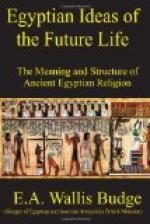The history of Osiris, the god of the resurrection, has now been traced from the earliest times to the end of the period of the rule of the priests of Amen (about B.C. 900), by which time Amen-R[=a] had been thrust in among the gods of the underworld, and prayers were made, in some cases, to him instead of to Osiris. From this time onwards Amen maintained this exalted position, and in the Ptolemaic period, in an address to the deceased Ker[=a]sher we read. “Thy face shineth before R[=a], thy soul liveth before Amen, and thy body is renewed before Osiris.” And again it is said, “Amen is nigh unto thee to make thee to live again.... Amen cometh to thee having the breath of life, and he causeth thee to draw thy breath within thy funeral house.” But in spite of this, Osiris kept and held the highest place in the minds of the Egyptians, from first to last, as the God-man, the being who was both divine and human; and no foreign invasion, and no religious or political disturbances, and no influence which any outside peoples could bring to bear upon them, succeeded in making them regard the god as anything less than the cause and symbol and type of the resurrection, and of the life everlasting. For about five thousand years men were mummified in imitation of the mummied form of Osiris; and they went to their graves believing that their bodies would vanquish the powers of death, and the grave, and decay, because Osiris had vanquished them; and they had certain hope of the resurrection in an immortal, eternal, and spiritual body, because Osiris had risen in a transformed spiritual body, and had ascended into heaven, where he had become the king and the judge of the dead, and had attained unto everlasting life therein.
The chief reason for the persistence of the worship of Osiris in Egypt was, probably, the fact that it promised both resurrection and eternal life to its followers. Even after the Egyptians had embraced Christianity they continued to mummify their dead, and for long after they continued to mingle the attributes of their God and the “gods” with those of God Almighty and Christ. The Egyptians of their own will never got away from the belief that the body must be mummified if eternal life was to be assured to the dead, but the Christians, though preaching the same doctrine of the resurrection as the Egyptians, went a step further, and insisted that there was no need to mummify the dead at all. St. Anthony the Great besought his followers not to embalm his body and keep it in a house, but to bury it and to tell no man where it had been buried, lest those who loved him should come and draw it forth, and mummify it as they were wont to do to the bodies of those whom they regarded as saints. “For long past,” he said, “I have entreated the bishops and preachers to exhort the people not to continue to observe this useless custom”; and concerning his own body, he said, “At the resurrection of the dead I shall receive it from the Saviour incorruptible.”




